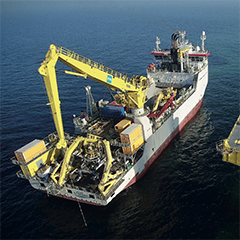The Jan De Nul Group has installed two gravity-based foundations in the Danish waters of the Baltic Sea. Built in Ostend, the foundations were designed entirely by Jan De Nul, based on their client’s basic design. PES wanted to learn more about this ground breaking wind farm.
By 2021, the 600MW Kriegers Flak Offshore Wind Farm in the Danish waters of the Baltic Sea, will generate enough electricity to power up to 600,000 homes. Transmission grid operators, Danish Energinet and German 50 Hertz, will connect the Kriegers Flak OWF with the German Baltic 2 OWF, thereby creating the first offshore power grid in the world to combine two offshore wind power installations with the possibility of supplying electricity to either or both, Denmark and Germany.
The power grid part of the project is co-financed by the EU. The Kriegers Flak wind farm consists of two sites, each with its own high voltage substation. The Jan De Nul Group, together with its consortium partner Iemants, were responsible for the foundations supporting both these substations.
The contract to design, build and install these two Gravity Based Substructures (GBSs) was awarded to the consortium during late 2016. Jan De Nul was in charge of the design, construction, installation and ballasting of the concrete GBSs while Iemants designed, fabricated and installed the steel top part where the substation is connected. Once transported and installed, Jan De Nul was also responsible for the foundation ballasting and the installation of the scour protection during the first quarter of 2018.
The Jan De Nul Group had already designed, constructed and installed gravity based structures before, but the size and weight of the Kriegers Flak structures were unprecedented: the GBS of the KFA substation of the Western part of the OWF, with a 200MW capacity) weighs 8,000 tonnes. The GBS of the KFBE substation of the Eastern part, with a 400MW capacity, weighs 10,000 tonnes. The size of both structures made this project even more challenging. Additionally, and for the first time, Jan De Nul designed these hybrid gravity-based foundations entirely in-house.
The design, a technical masterpiece
The design is a technical masterpiece. The foundations must be able to withstand the forces of water and wind and, at the same time, carry the weight of the substations. The design is based on a floating installation concept which means that the structures, although each having a significant weight, can still be towed to site.
The largest KFBE substation will also act as an interconnector between the Kriegers Flak wind farm on one side, and the mainland of Denmark and Germany on the other side. On the wind farm side, the design had to accommodate 21 massive J-tubes running through the shafts towards the outside of the caisson. In combination with the lifetime design requirements of the structure and the resulting impact loads, this meant that the reinforcement calculations were a complex challenge that had to be overcome.
All of this resulted in a very complex design process, as it was necessary to consider both the lifetime operation of the GBSs and also the temporary installation position, where both positions have an impact on certain parts of the substructures.
To fully observe the complexity of the design and the importance of the behavior of the structures in floating conditions, during both transport and installation, a 1/24 scaled version of the initial GBS design was fabricated. A number of model tests were completed in the basin of Oceanide in order to determine motion responses, and towline tensions of both GBSs when afloat, and to fine-tune the gravel bed and seabed scour protection designs. These basin tests proved to be extremely useful and allowed Jan De Nul to provide the client and the marine warranty surveyor with a clear proof of concept.
From start to finish, it took less than 6 months to deliver a fully certified structural and geotechnical masterpiece.



























